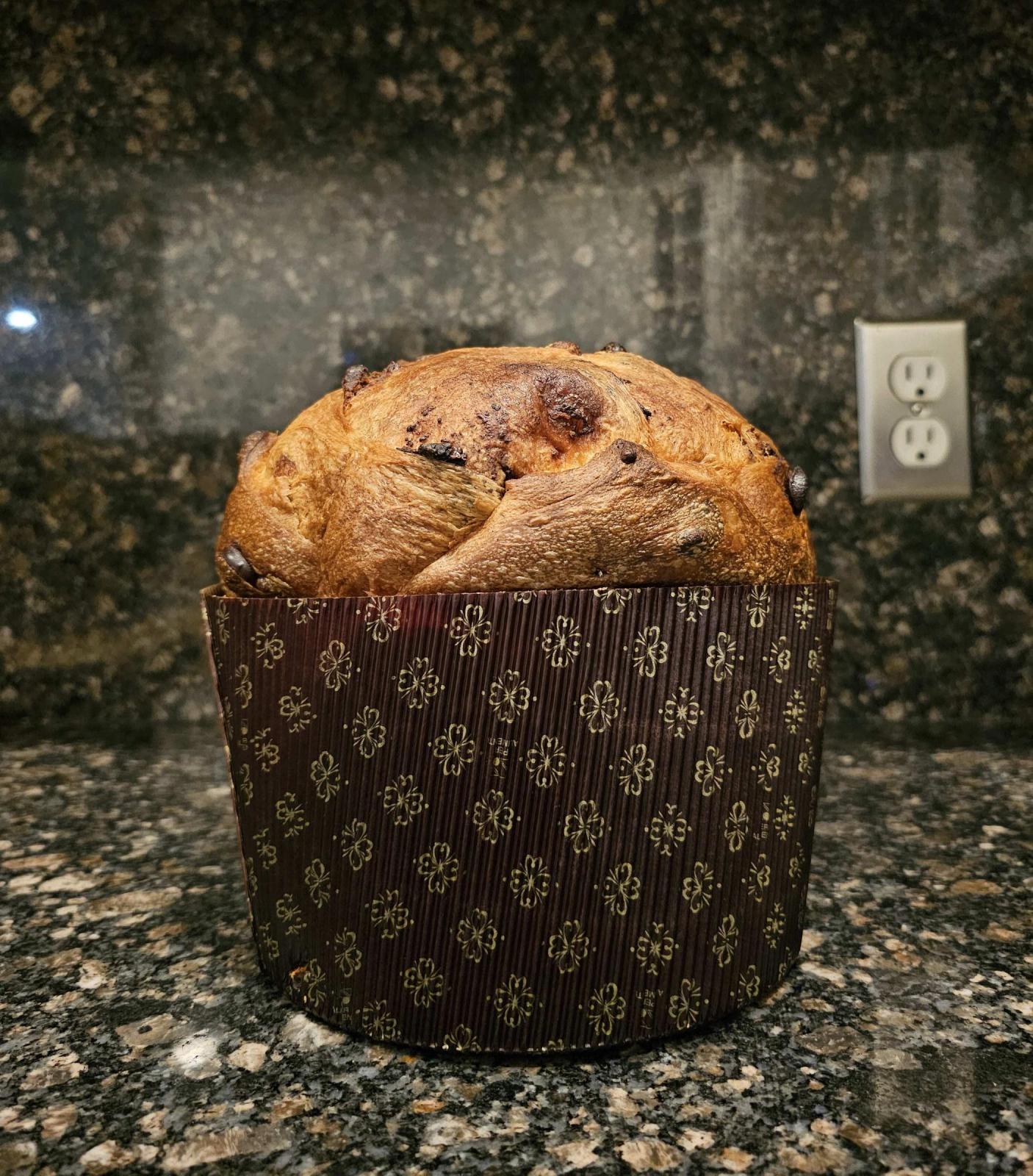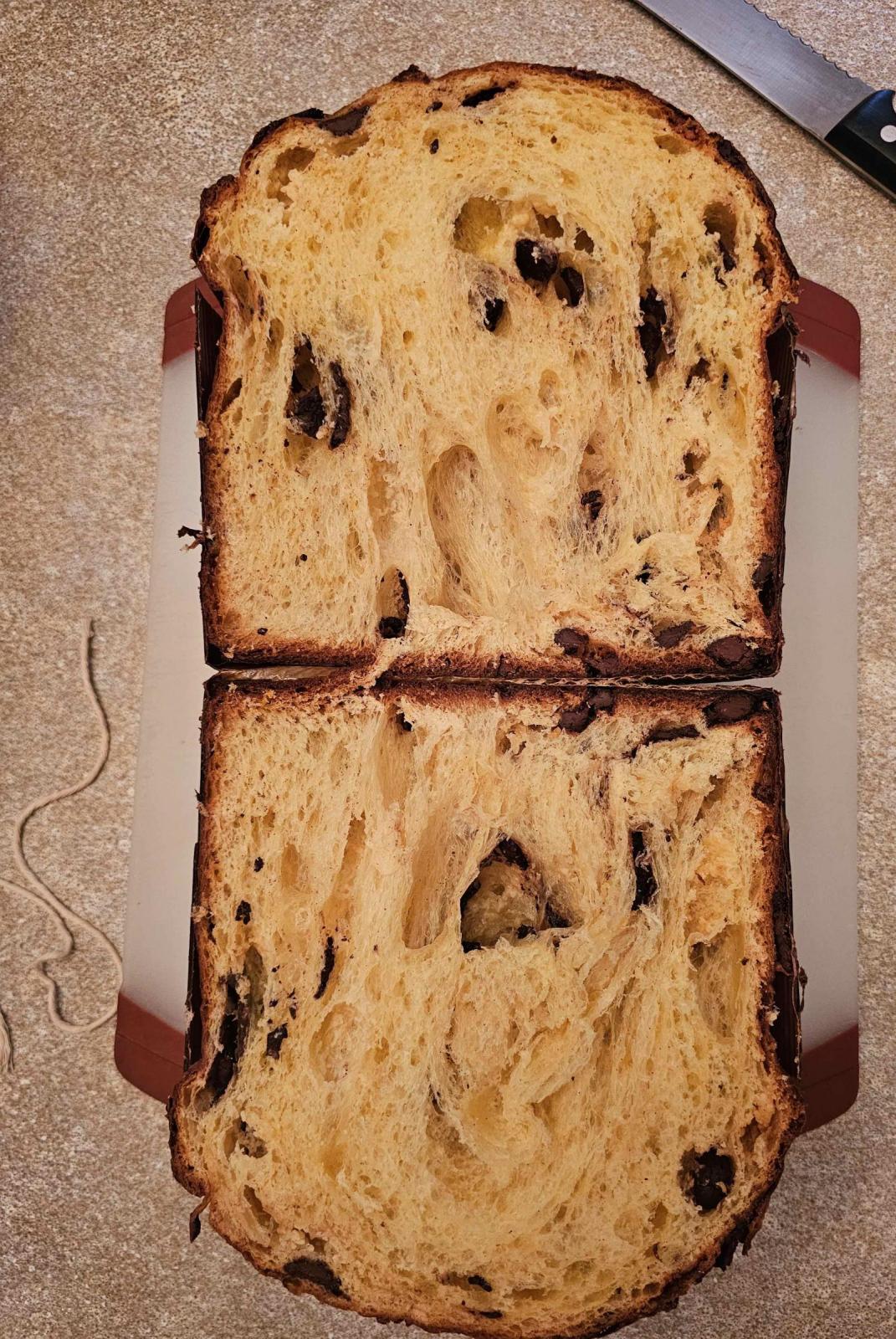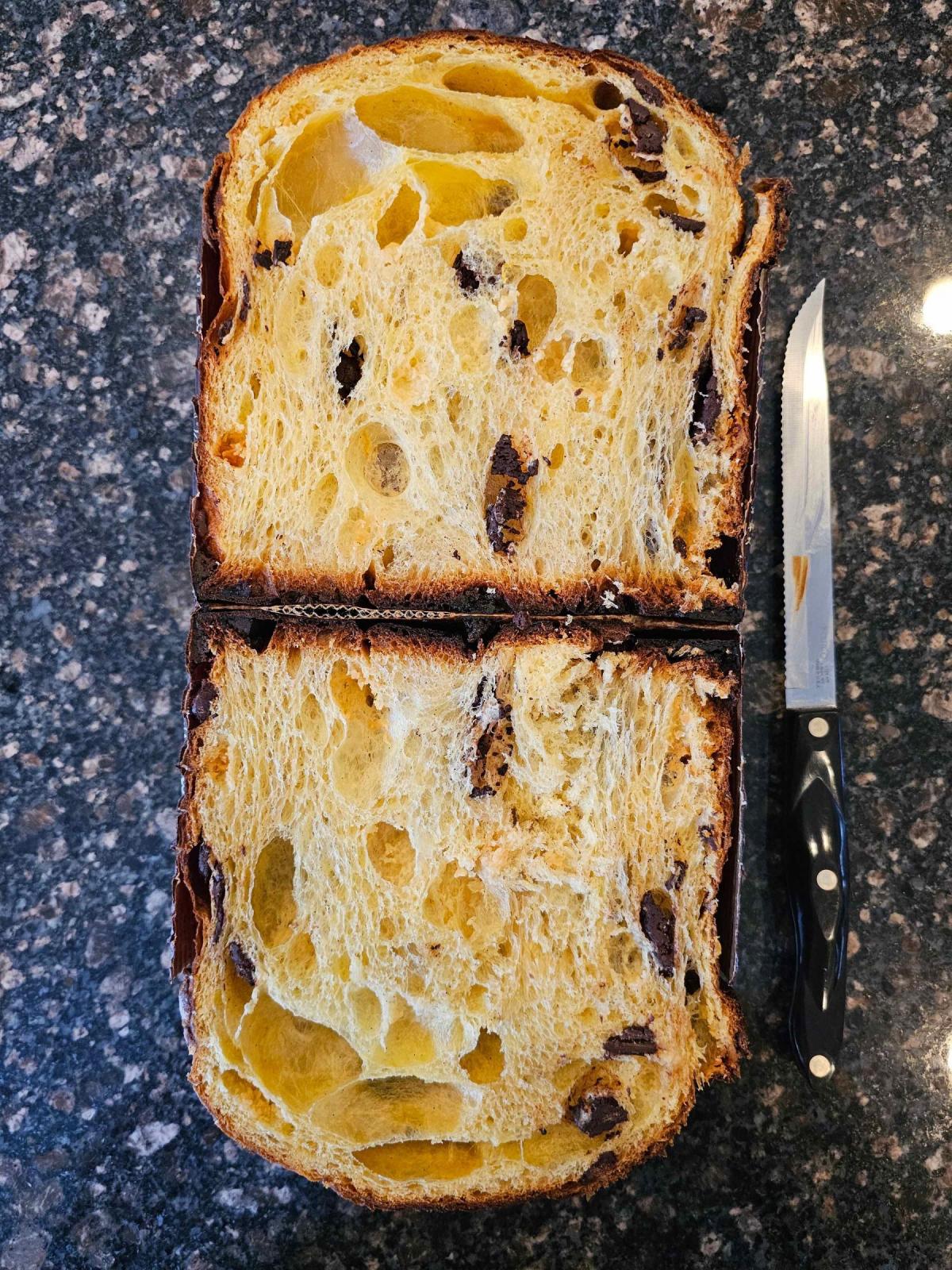

Almost exactly two years ago, I stopped lurking on this site and finally posted something - a plea for help. I had been making panettone with a liquid sourdough starter for a few years before switching to a lievito madre and I could not figure out why my dough was turning to soup when adding the butter. Looking back, the key thing I didn't realize was just how little I understood about the process.
Fast forward two years and another desperate post trying to make sense of all this and I've finally found some success in making panettone leavened with lievito madre. I've lost count of how many times I've failed over those two years - primi that didn't rise, secondi that turned to soup, flat tops, blowouts, panettoni falling out of the mold - the list goes on. I often failed spectacularly. So many ingredients in the trash and so much disappointment and frustration often met by friends and family with "Why bother? Can't you just buy one?".
I followed EIDB's panettone recipe from Sourdough Panettone and Viennoiserie. This is the recipe I started with a few years ago, thinking I should try the recipe by the person who wrote the book, not having realized that the book both literally and figuratively had already been written in one way or another by the maestri featured in SPV, among some others. At the time, I wasn't familiar with the maestri or their formulas, but even after discovering them, I wanted to continue using the same formula to eliminate variables when things went wrong, as they often did. At one point, when butter was my nemesis, I scrutinized all of the formulas in SPV to try and find one that didn't contain an outrageous amount of butter and found that EIDB's wasn't too bad in that regard, so I stuck with it.
In the past, I used whatever strong flours I had access to, which all happened to be malted. At some point, I decided that malted flours were a bad idea, at least until I had enough experience to deal with them. I could never get them to work, so when I created my new LM I used Caputo's Manitoba Oro, which I also used for the primo and secondo.
I did modify the formula a bit. Rather than orange paste, I used orange and lemon zest along with vanilla bean. I did not add the bassinage water because the recipe says something like "add the bassinage water if necessary" and I was never really sure what necessitated bassinage water. Given my history of failed secondi, I thought it best to leave it out. For inclusions, I used white and dark chocolate since candying orange peel was something I gave up when the end product seemed to constantly be in question.
I guess the most important part, my LM, was not maintained according to any specific formula or plan. For the most part, my LM is constantly in maintenance mode with a single refreshment before letting it rest for nearly 24 hours at 16 - 17C. A few times a week I will expose it to heat with either a warm refreshment or hot bagnetto. I typically keep the LM in water, but if I notice it getting sluggish or not rising well, I'll use free maintenance for a few days. If I know that I won't be able to refresh it for a day or two, I bind it and put it in the fridge. It's all a balancing act between my schedule and what the LM seems to need. I do tend to push it pretty hard towards acetic since the failures still leave me with a really good loaf of bread.
I played a little bit with refreshment ratios along the way as well. I noticed that refreshing 1:1 (starter:flour) and leaving at 16 - 17C for 20 - 24 hours would yield a pH right around 4.0, but refreshing 1:2 with all else kept the same would yield a pH of 3.8 - 3.9, but with a less dramatic rise. Seeing how higher flour ratios would drive pH lower, I also experimented with ratios during the warm refreshments. For this bake, I refreshed 1:1.25 at 28C (about 5.5 hrs) for the first followed by 1:1 at 28C (about 4hrs) for the second. I didn't perform a 3rd. Two refreshments in this way also wound up being a lot more convenient with my schedule. Regardless of the warm refreshments, I can't seem to hit 4.0 - 4.1. Once the starter has tripled, I've been using the LM at around pH 4.15 - 4.25, though I've been trying to get sub 4.1 to see if it helps at all with primo acidification.
I still had issues, of course, the main one being the seemingly infamous primo acidification. I think my primo was about pH 4.3 by the time it had tripled. It also tripled in only about 10 hours which is very fast considering I closed the primo at about 22C. The panettone also seemed to get a bit darker than I wanted. I set my oven according to a thermometer placed on the rack where the panettone would go, but I guess that means that maybe higher up in the oven, where the panettone would rise, was too hot. In the past, I glazed most of the panettoni I've baked and hadn't had this problem, but after many flat tops I decided not to glaze, thinking that the glaze was maybe hardening early and preventing some oven spring.
In any case, the panettone was delicious. So light and delicate that it was almost difficult to slice, yet strong enough to hold its shape and pass the "cotton candy test". Not quite where I want it to be, but a massive success for me nonetheless.
Edit: A picture of the crumb from the second loaf from the same batch, cut one week after baking. I didn't butcher this one as much when slicing it. This one was a bit darker on the outside and cooked to a higher internal temperature (unintentionally - used a different oven that I'm not as used to), so I thought this one would be in rough shape but I'm very happy with this crumb.
I really went for it - the bake right before this resulted in the panettone falling out of the mold when I hung it. So, a few days later I decided to change almost nothing and bake 2 instead of 1 😅. The previous bake was glazed - I wonder if I went too heavy on the glaze, weighing down the dome and causing it to fall. My LM was not significantly different between the two bakes - certainly not "fall from the mold" lactic.

- joegranz's Blog
- Log in or register to post comments
Just fantastic result, so great to see it! Nice looking crumb!! I'm happy for you!
--Sue
Thanks Sue! I appreciate your contributions to the posts I've mentioned as well. Your posts about your panettone, along with Michael's and some of the more recent success stories, are great motivation.
Looks great!
Thank you!
Well done, that's a fantastic looking panettone! Nice vertical crumb and strong bloom. I can only imagine how great it must feel to achieve this after such a long time working on it.
Last step in the puzzle is eliminating the primo acidification... Which I am working on... Still...!
Keep at it,
Michael
No words, Michael. I want to say you have no idea how good it feels, but TFL was my first stop after baking this because you all might be the only ones who understand!
Regarding the primo acidification - have you explored the influence of oxygen at all? At the very least, maybe you can save me this experiment if you've already tried something similar.
I'm wondering if the planetary mixers most of us use introduce too much oxygen, thereby speeding up fermentation. I've been thinking about trying to mix the primo in as little time as possible, with as little mixing as possible, maybe with the help of an autolyse. Have you tried this? My primo usually takes 35 - 45 minutes to mix, though I've been wondering how critical it is to knead thoroughly enough to get that really thin window pane, i.e. how much gluten development is actually necessary in the primo.
I think you can afford to shorten those mix times. With my planetary mixer, 20-25 minutes is enough for me to obtain a fully developed primo impasto. Probably technique plays a part here.
My thinking about oxygen was more so with respect to redox potential, something which is influenced over the various stages of fermentation. Of course, it’s important to not overwork or overheat the dough, however when it comes to panettone doughs, oxygenation is very much promoted by the maestros. For example, the double diving-arm mixer preferred by professionals for making panettone, is described by its manufacturers for its ability to oxygenate the dough well. Also, Iginio Massari puts importance on seeing air bubbles under the skin of the dough at the end of the mix.
Any advancing of fermentation is more so to do with dough temperature. In large scale production desired dough temperature (DDT) becomes ever more important. After mixing any remaining molecular oxygen is typically taken up by the yeasts. They can make better use of it and tend to utilise it in short order.
PS. Redox potential and how to influence it is a whole other topic.
Ah, so the twin-arm mixers likely oxygenate the dough far better than planetary mixers, meaning "too much oxygen" probably isn't the issue. I've always gotten air bubbles under the skin of the dough when mixing, so good to know that's a good sign.
Joe a huge congratulations to you for your success and persistence, it has all paid off. The crumb is quite incredible. One day I hope to dip my toes into the seas of panettone baking, however that day isn’t today.
Benny
Joe, I am so excited for you, as I am for everyone who sees through a panetonne project. It is impossible not to admire your tenacity in staying the course. The panetonne looks beautiful and your feeling of accomplishment must be incredible. It is certainly well-deserved. Enjoy every moment. Happy New Year! 🥂
Just wow. Congratulations on your success in baking one of the most difficult things to bake on the planet!
It seems I don't get notifications for comments on blog posts. Thank you all for the kind words - it's a great feeling to finally complete the process from start to finish. I now look forward to refining the process and trying out different formulas. With any luck, you'll be sick of my panettone posts in no time!
Do you have any pictures of your liquid starter panettone? What was your method? I'm having failure with any kind of starter...